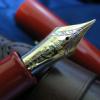Search the Community
Showing results for tags '845'.
-
Good day, I’m a new member from Chicago and I have a fledgling collection. The only Pilot I have is a basic metropolitan, yet now, I’m quite interested in a higher-end model like the Custom 845. I’d like to ask you owners about your thoughts about the pen in terms of nib feel...
-
Namiki Yukari Royale versus Pilot Custom 845 http://farm8.staticflickr.com/7346/11918876405_a4b358c5a4_b.jpg Introducing the Namiki Yukari Royale in Black Urushi (top) and the Pilot Custom 845 (bottom). Both pens are resting on a Nakaya three-pen pillow in Kuro Tamenuri Urushi on top of a Midori p...
- 45 replies


